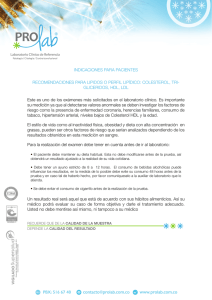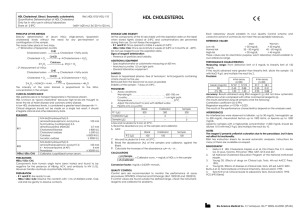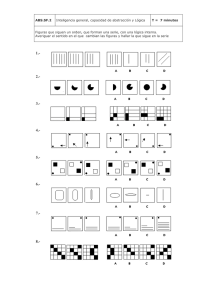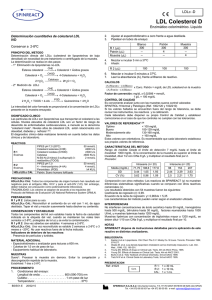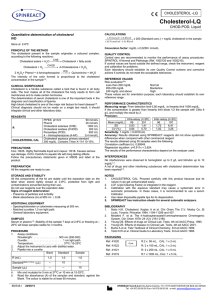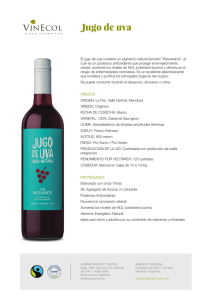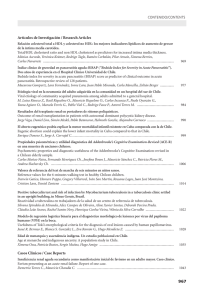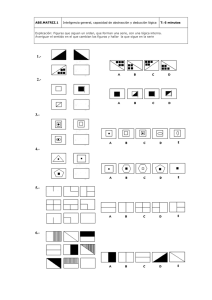Instrucciones de úso
Anuncio
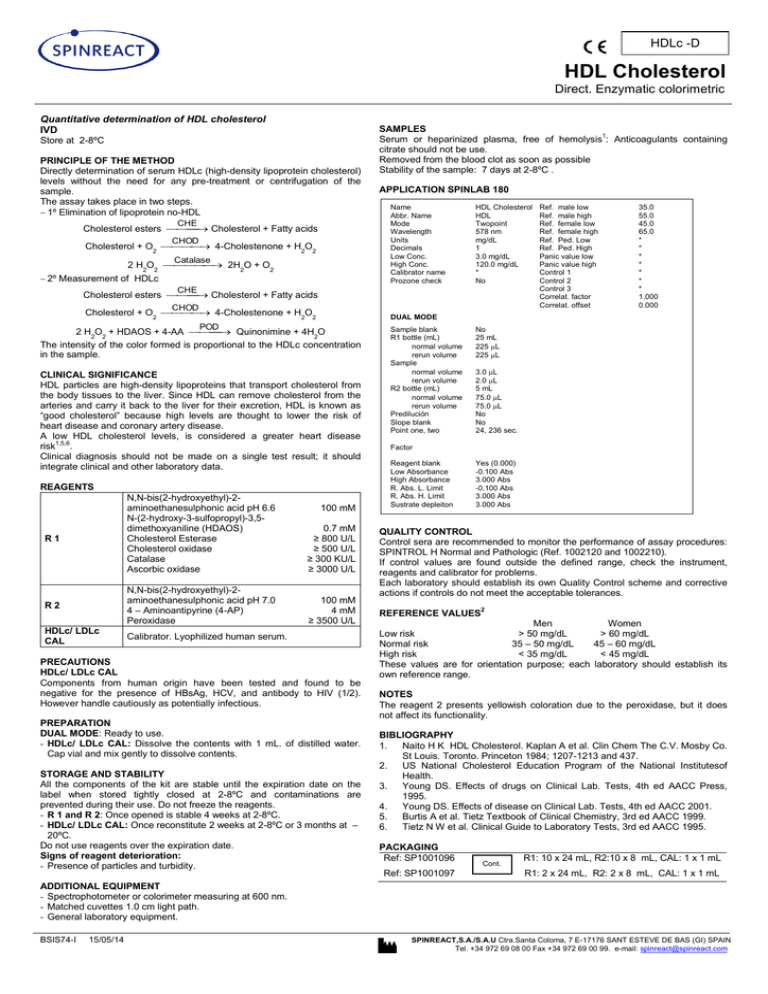
HDLc -D HDL Cholesterol Direct. Enzymatic colorimetric Quantitative determination of HDL cholesterol IVD Store at 2-8ºC PRINCIPLE OF THE METHOD Directly determination of serum HDLc (high-density lipoprotein cholesterol) levels without the need for any pre-treatment or centrifugation of the sample. The assay takes place in two steps. 1º Elimination of lipoprotein no-HDL CHE Cholesterol esters Cholesterol + Fatty acids CHOD Cholesterol + O2 4-Cholestenone + H2O2 Catalase 2 H2O2 2H2O + O2 2º Measurement of HDLc SAMPLES Serum or heparinized plasma, free of hemolysis1: Anticoagulants containing citrate should not be use. Removed from the blood clot as soon as possible Stability of the sample: 7 days at 2-8ºC . APPLICATION SPINLAB 180 Name Abbr. Name Mode Wavelength Units Decimals Low Conc. High Conc. Calibrator name Prozone check HDL Cholesterol HDL Twopoint 578 nm mg/dL 1 3.0 mg/dL 120.0 mg/dL * No CHE Cholesterol esters Cholesterol + Fatty acids CHOD Cholesterol + O2 4-Cholestenone + H2O2 35.0 55.0 45.0 65.0 * * * * * * * 1.000 0.000 DUAL MODE POD 2 H2O2 + HDAOS + 4-AA Quinonimine + 4H2O The intensity of the color formed is proportional to the HDLc concentration in the sample. CLINICAL SIGNIFICANCE HDL particles are high-density lipoproteins that transport cholesterol from the body tissues to the liver. Since HDL can remove cholesterol from the arteries and carry it back to the liver for their excretion, HDL is known as “good cholesterol” because high levels are thought to lower the risk of heart disease and coronary artery disease. A low HDL cholesterol levels, is considered a greater heart disease risk1,5,6. Clinical diagnosis should not be made on a single test result; it should integrate clinical and other laboratory data. REAGENTS N,N-bis(2-hydroxyethyl)-2aminoethanesulphonic acid pH 6.6 N-(2-hydroxy-3-sulfopropyl)-3,5dimethoxyaniline (HDAOS) Cholesterol Esterase Cholesterol oxidase Catalase Ascorbic oxidase 0.7 mM ≥ 800 U/L ≥ 500 U/L ≥ 300 KU/L ≥ 3000 U/L R2 N,N-bis(2-hydroxyethyl)-2aminoethanesulphonic acid pH 7.0 4 – Aminoantipyrine (4-AP) Peroxidase 100 mM 4 mM ≥ 3500 U/L HDLc/ LDLc CAL Calibrator. Lyophilized human serum. R1 Ref. male low Ref. male high Ref. female low Ref. female high Ref. Ped. Low Ref. Ped. High Panic value low Panic value high Control 1 Control 2 Control 3 Correlat. factor Correlat. offset 100 mM PRECAUTIONS HDLc/ LDLc CAL Components from human origin have been tested and found to be negative for the presence of HBsAg, HCV, and antibody to HIV (1/2). However handle cautiously as potentially infectious. PREPARATION DUAL MODE: Ready to use. - HDLc/ LDLc CAL: Dissolve the contents with 1 mL. of distilled water. Cap vial and mix gently to dissolve contents. STORAGE AND STABILITY All the components of the kit are stable until the expiration date on the label when stored tightly closed at 2-8ºC and contaminations are prevented during their use. Do not freeze the reagents. - R 1 and R 2: Once opened is stable 4 weeks at 2-8ºC. - HDLc/ LDLc CAL: Once reconstitute 2 weeks at 2-8ºC or 3 months at – 20ºC. Do not use reagents over the expiration date. Signs of reagent deterioration: - Presence of particles and turbidity. Sample blank R1 bottle (mL) normal volume rerun volume Sample normal volume rerun volume R2 bottle (mL) normal volume rerun volume Predilución Slope blank Point one, two No 25 mL 225 L 225 L 3.0 L 2.0 L 5 mL 75.0 L 75.0 L No No 24, 236 sec. 5.0 Vol. repet. Retr., tiemp Factor Reagent blank Low Absorbance High Absorbance R. Abs. L. Limit R. Abs. H. Limit Sustrate depleiton Vol. repet. Yes (0.000) -0.100 Abs 3.000 Abs -0.100 Abs 3.000 Abs 3.000 Abs QUALITY CONTROL Control sera are recommended to monitor the performance of assay procedures: SPINTROL H Normal and Pathologic (Ref. 1002120 and 1002210). If control values are found outside the defined range, check the instrument, reagents and calibrator for problems. Each laboratory should establish its own Quality Control scheme and corrective actions if controls do not meet the acceptable tolerances. REFERENCE VALUES2 Men Women Low risk > 50 mg/dL > 60 mg/dL Normal risk 35 – 50 mg/dL 45 – 60 mg/dL High risk < 35 mg/dL < 45 mg/dL These values are for orientation purpose; each laboratory should establish its own reference range. NOTES The reagent 2 presents yellowish coloration due to the peroxidase, but it does not affect its functionality. BIBLIOGRAPHY 1. Naito H K HDL Cholesterol. Kaplan A et al. Clin Chem The C.V. Mosby Co. St Louis. Toronto. Princeton 1984; 1207-1213 and 437. 2. US National Cholesterol Education Program of the National Institutesof Health. 3. Young DS. Effects of drugs on Clinical Lab. Tests, 4th ed AACC Press, 1995. 4. Young DS. Effects of disease on Clinical Lab. Tests, 4th ed AACC 2001. 5. Burtis A et al. Tietz Textbook of Clinical Chemistry, 3rd ed AACC 1999. 6. Tietz N W et al. Clinical Guide to Laboratory Tests, 3rd ed AACC 1995. PACKAGING Ref: SP1001096 Ref: SP1001097 Cont. . R1: 10 x 24 mL, R2:10 x 8 mL, CAL: 1 x 1 mL R1: 2 x 24 mL, R2: 2 x 8 mL, CAL: 1 x 1 mL ADDITIONAL EQUIPMENT - Spectrophotometer or colorimeter measuring at 600 nm. - Matched cuvettes 1.0 cm light path. - General laboratory equipment. BSIS74-I 15/05/14 SPINREACT,S.A./S.A.U Ctra.Santa Coloma, 7 E-17176 SANT ESTEVE DE BAS (GI) SPAIN Tel. +34 972 69 08 00 Fax +34 972 69 00 99. e-mail: [email protected] HDLc -D Colesterol HDL Directo. Enzimático colorimétrico Determinación cuantitativa de colesterol HDL IVD. - Equipamiento habitual de laboratorio. Conservar a 2-8ºC MUESTRAS Suero o plasma:1 No usar anticoagulantes con citrato. No utilizar muestras hemolizadas. Separar el suero de los hematies lo antes posible. Estabilidad de la muestra: 7 días a 2-8ºC. PRINCIPIO DEL MÉTODO Determinación directa del HDLc (colesterol de lipoproteínas de alta densidad) sin necesidad de pre-tratamiento o centrifugado de la muestra. La determinación se realiza en dos pasos: 1º Eliminación de lipoproteínas no-HDL CHE Ésteres colesterol Colesterol + Ácidos grasos CHOD Colesterol + O2 4-Colestenona + H2O2 Catalasa 2 H2O2 2H2O + O2 2º Medición de HDLc CHE Ésteres colesterol Colesterol + Ácidos grasos APLICACIÓN AL SPINLAB 180 Nombre Nombre abreviado Modo Long. ondas Unidades Decimales Conc. Inferior Conc. Superior Calibrador Chequeo prozona HDL Colesterol HDL Twopoint 578 nm mg/dL 1 3.0 mg/dL 120.0 mg/dL * No CHOD Colesterol + O2 4-Colestenona + H2O2 POD 2 H2O2 + HDAOS + 4-AA Quinonimina + 4H2O La intensidad del color formado es proporcional a la concentración de HDLc presente en la muestra ensayada. SIGNIFICADO CLÍNICO Las partículas de HDL son lipoproteínas de alta densidad que transportan el colesterol desde los tejidos del cuerpo hasta el hígado. Debido a que las HDL pueden retirar el colesterol de las arterias y transportarlo de vuelta al hígado para su excreción, se les conoce como el colesterol o ‘lipoproteína buena’, ya que niveles elevados están relacionados con un menor riesgo cardiovascular. Un nivel bajo de colesterol HDL es considerado uno de los principales factores de riesgo cardiovascular y enfermedades de las arterias coronarias1,5,6. El diagnóstico clínico debe realizarse teniendo en cuenta todos los datos clínicos y de laboratorio. REACTIVOS N,N-bis (2-hidroxietil)-2aminoetanosulfonico acido pH 6.6 N-(2-hidroxi-3-sulfopropil)-3,5dimetoxianilina (HDAOS) Colesterol esterasa Colesterol oxidasa Catalasa Ascórbico oxidasa R1 N,N-bis (2-hidroxietil)-2aminoetanosulfonico acido pH 7,0 4 – Aminoantipirina Peroxidasa R2 HDLc/ LDLc CAL 100 mM 0.7 mM ≥800 U/L ≥ 500U/L ≥300 KU/L ≥3000 U/L 100 mM 4 mM ≥ 3500 U/L Calibrador. Suero humano liofilizado. PRECAUCIONES HDLc/ LDLc CAL Los componentes de origen humano han resultado ser negativos para el antígeno HBs, HCV y para el anti-HIV (1/2). Sin embargo, deben tratarse con precaución como potencialmente infecciosos. PREPARACIÓN MODO DUAL : Reactivos listos para su uso. HDLc/LDLc CAL : Reconstituir el contenido de un vial con 1 mL. de agua destilada.Tapar el vial y mezclar suavemante hasta disolver su contenido. CONSERVACIÓN Y ESTABILIDAD Todos los componentes del kit son estables hasta la fecha de caducidad indicada en la etiqueta del vial, cuando se mantienen los viales bien cerrados a 2-8ºC, protegidos de la luz y se evita la contaminación. No congelar los reactivos. - R 1 y R 2: Una vez abiertos son estables 4 semanas a 2-8ºC. - HDLc/ LDLc CAL: Una vez reconstituido es estable 2 semanas a 2-8ºC o 3 meses a –20ºC. No usar reactivos fuera de la fecha indicada. Indicadores de deterioro de los reactivos: - Presencia de partículas y turbidez. Ref. Hombre Inf. Ref. Hombre Sup. Ref. Mujer Inf. Ref. Mujer Sup. Ref. Ped. Inf. Ref. Ped. Sup. Valor pánico bajo Valor pánico alto Control 1 Control 2 Control 3 Factor correl. Offset de correl. 35.0 55.0 45.0 65.0 * * * * * * * 1.000 0.000 MODO DUAL Blanco muestra Frasco R1 (mL) Vol. normal Vol. repet. Muestra Vol. normal Vol. repet. Frasco R2 (mL) Vol. normal Vol. repet. Predilución Pendiente Blco. 1º, 2º punto No 25 mL 225 L 225 L Factor ** Blanco reactivo Absorbancia inf. Absorbancia sup. Lim.Inf. Abs. React. Lim.Sup. Abs. React. Agotamiento sustrato Si (0.000) -0.100 Abs 3.000 Abs -0.100 Abs 3.000 Abs 3.000 Abs 3.0 L 2.0 L 5 mL 75.0 L 75.0 L No No 24, 236 seg. CONTROL DE CALIDAD Es conveniente analizar junto con las muestras sueros control valorados: SPINTROL H Normal y Patológico (Ref. 1002120 y 1002210). Si los valores hallados se encuentran fuera del rango de tolerancia, revisar el instrumento, los reactivos y el calibrador. Cada laboratorio debe disponer su propio Control de Calidad y establecer correcciones en el caso de que los controles no cumplan con las tolerancias. VALORES DE REFERENCIA2 Hombres > 50 mg/dL 35 – 50 mg/dL < 35 mg/dL Riesgo menor Riesgo normal Riesgo elevado Mujeres > 60 mg/dL 45 – 60 mg/dL < 45 mg/dL Estos valores son orientativos. Es recomendable que cada laboratorio establezca sus propios valores de referencia. NOTAS El reactivo 2 presenta coloración amarillenta debido a la peroxidasa que contiene, lo cual no afecta en absoluto la funcionalidad del reactivo. BIBLIOGRAFÍA 1. Naito H K HDL Cholesterol. Kaplan A et al. Clin Chem The C.V. Mosby Co. St Louis. Toronto. Princeton 1984; 1207-1213 and 437. 2. US National Cholesterol Education Program of the National Institutesof Health. 3. Young DS. Effects of drugs on Clinical Lab. Tests, 4th ed AACC Press, 1995. 4. Young DS. Effects of disease on Clinical Lab. Tests, 4th ed AACC 2001. 5. Burtis A et al. Tietz Textbook of Clinical Chemistry, 3rd ed AACC 1999. 6. Tietz N W et al. Clinical Guide to Laboratory Tests, 3rd ed AACC 1995. PRESENTACIÓN Ref: SP1001096 Ref: SP1001097 Cont. . R1: 10 x 24 mL, R2:10 x 8 mL, CAL: 1 x 1 mL R1: 2 x 24 mL, R2: 2 x 8 mL, CAL: 1 x 1 mL MATERIAL ADICIONAL - Espectrofotómetro o analizador con cubeta para lecturas a 600 nm. - Cubetas de 1,0 cm de paso de luz. BSIS74-E 15/05/14 SPINREACT,S.A./S.A.U Ctra.Santa Coloma, 7 E-17176 SANT ESTEVE DE BAS (GI) SPAIN Tel. +34 972 69 08 00 Fax +34 972 69 00 99. e-mail: [email protected]
